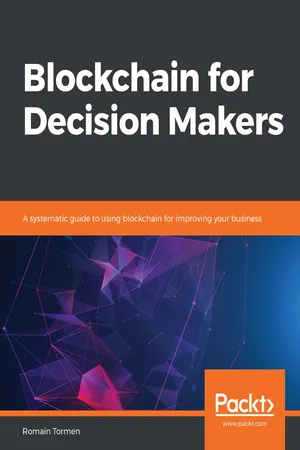
Blockchain for Decision Makers
A systematic guide to using blockchain for improving your business
- 184 pages
- English
- ePUB (mobile friendly)
- Available on iOS & Android
Blockchain for Decision Makers
A systematic guide to using blockchain for improving your business
About This Book
Understand how blockchain works and explore a variety of strategies to implement it in your organization effectively
Key Features
- Become familiar with business challenges faced by companies when using blockchain
- Discover how companies implement blockchain to monetize and secure their data
- Study real-world examples to understand blockchain and its use in organizations
Book Description
In addition to cryptocurrencies, blockchain-based apps are being developed in different industries such as banking, supply chain, and healthcare to achieve digital transformation and enhance user experience. Blockchain is not only about Bitcoin or cryptocurrencies, but also about different technologies such as peer-to-peer networks, consensus mechanisms, and cryptography. These technologies together help sustain trustless environments in which digital value can be transferred between individuals without intermediaries.
This book will help you understand the basics of blockchain such as consensus protocols, decentralized applications, and tokenization. You'll focus on how blockchain is used today in different industries and the technological challenges faced while implementing a blockchain strategy. The book also enables you, as a decision maker, to understand blockchain from a technical perspective and evaluate its applicability in your business. Finally, you'll get to grips with blockchain frameworks such as Hyperledger and Quorum and their usability.
By the end of this book, you'll have learned about the current use cases of blockchain and be able to implement a blockchain strategy on your own.
What you will learn
- Become well-versed with how blockchain works
- Understand the difference between blockchain and Bitcoin
- Learn how blockchain is being used in different industry verticals such as finance and retail
- Delve into the technological and organizational challenges of implementing blockchain
- Explore the possibilities that blockchain can unlock for decision makers
- Choose a blockchain framework best suited for your projects from options such as Ethereum and Hyperledger Fabric
Who this book is for
This book is for CXOs, business professionals, organization leaders, decision makers, technology enthusiasts, and managers who wish to understand how blockchain is implemented in different organizations, its impact, and how it can be customized according to business needs. Prior experience with blockchain is not required.
Frequently asked questions
Information
Section 1: A First Step into Blockchain and an Exciting World
- Chapter 1, Basics of Blockchain and the Illustration of Village Beta
- Chapter 2, A Technical Dive into Blockchain
- Chapter 3, Ethereum and Smart Contracts
- Chapter 4, ICOs and Tokenized Fundraising Methods
Basics of Blockchains and the Illustration of Village Beta
- The significance of blockchain in the business world
- Understanding blockchains
- Breaking down blockchains
The significance of blockchain in the business world
Understanding blockchains
Using centralized ledger systems
Table of contents
- Title Page
- Copyright and Credits
- About Packt
- Contributors
- Preface
- Section 1: A First Step into Blockchain and an Exciting World
- Basics of Blockchains and the Illustration of Village Beta
- A Technical Dive into Blockchain
- Ethereum and Smart Contracts
- ICOs and Tokenized Fundraising Methods
- Section 2: Blockchain in Practice, Insights, and Achievements
- An Economic and Historical Approach of Blockchain
- Blockchain Legality, Compliance, and Regulation
- Blockchain for the Business World and Achievements
- Future Outlook for Blockchain
- Section 3: Blockchain for Business Leaders
- Infrastructures and Cloud-Based Solutions
- Defining Your Needs
- Other Books You May Enjoy